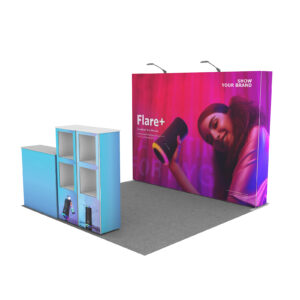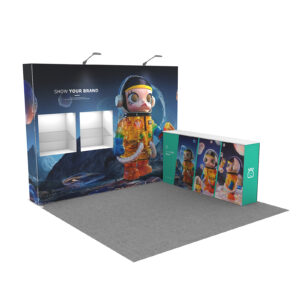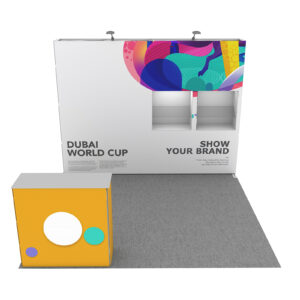Trade shows are a prime opportunity for businesses to showcase their products, services, and innovations. A well-executed trade show display design can attract potential customers, build brand awareness, and drive sales. In this guide, we will delve into the essential elements of creating an effective trade show exhibition booth design, providing insights and strategies to help you stand out at your next event.
Understanding The Importance Of Trade Show Display Design
Trade show display design is a critical aspect of your overall marketing strategy. It’s more than just setting up a booth; it’s about creating an immersive experience that engages visitors and communicates your brand message effectively. A captivating display can draw in attendees from across the exhibition floor, making your booth a hub of activity and interest.
Setting Clear Objectives For Your Trade Show Booth

Before diving into the design process, it’s essential to establish clear objectives for your trade show participation. These objectives will guide your design decisions and help measure the success of your efforts. Common goals include:
- Generating leads
- Building brand awareness
- Launching new products
- Networking with industry professionals
- Conducting market research
With these objectives in mind, you can tailor your trade show display design to achieve your specific goals.
Designing For Impact: Key Elements Of A Trade Show Booth
1. Branding Consistency
Your trade show booth should be an extension of your brand. Consistent use of colors, logos, and messaging ensures that attendees instantly recognize your company. Strong branding reinforces your identity and builds trust with potential customers.
2. Attention-Grabbing Graphics
High-quality graphics are crucial for attracting visitors. Use bold, vibrant images and concise, impactful text to convey your message quickly. Remember, you have only a few seconds to capture the attention of passersby, so make every visual element count.
3. Functional Layout
The layout of your booth should facilitate easy navigation and interaction. Consider the flow of foot traffic and ensure there are clear pathways for visitors. Incorporate distinct areas for product displays, demonstrations, and meetings to create a cohesive and functional space.
4. Interactive Elements
Interactive elements such as touch screens, VR experiences, and live demonstrations can significantly enhance visitor engagement. These elements not only attract attention but also provide an opportunity for attendees to interact with your products or services firsthand.
5. Lighting and Ambiance
Lighting plays a vital role in setting the mood and highlighting key areas of your booth. Use a combination of ambient, accent, and task lighting to create an inviting and dynamic atmosphere. Proper lighting can make your booth stand out even in a crowded exhibition hall.
Crafting An Engaging Visitor Experience

1. Pre-Show Marketing
Your efforts should start well before the trade show begins. Utilize social media, email campaigns, and your website to promote your participation and generate buzz. Offering incentives such as exclusive previews or giveaways can entice attendees to visit your booth.
2. Staff Training
Your booth staff are the face of your company during the event. Ensure they are well-trained, knowledgeable about your products, and skilled in engaging with attendees. Their ability to communicate effectively can make or break the success of your trade show exhibition booth design.
3. Engaging Presentations
Scheduled presentations or demonstrations can attract larger crowds to your booth. Make these sessions informative, engaging, and relevant to your audience. Use multimedia tools to enhance the presentation and keep attendees captivated.
4. Lead Capture and Follow-Up
Effective lead capture is essential for maximizing your trade show ROI. Use digital tools such as QR codes, tablets, or mobile apps to collect contact information. Develop a follow-up strategy to nurture these leads post-event, ensuring that your trade show efforts translate into tangible business opportunities.
Evaluating Your Trade Show Success
Post-event evaluation is crucial for understanding the effectiveness of your trade show display design and overall participation. Here are some metrics to consider:
- Lead Quantity and Quality: Assess the number of leads generated and their potential value.
- Brand Exposure: Measure social media engagement, press coverage, and website traffic spikes during and after the event.
- Sales Impact: Track any immediate sales or future business opportunities that resulted from the trade show.
- Visitor Feedback: Gather feedback from booth visitors to identify strengths and areas for improvement.
Trends In Trade Show Display Design
1. Sustainable Booth Designs
Sustainability is becoming increasingly important in trade show display design. Eco-friendly materials, reusable components, and energy-efficient lighting are gaining popularity as companies strive to reduce their environmental impact.
2. Technology Integration
Advanced technologies such as augmented reality (AR), virtual reality (VR), and interactive touch screens are transforming trade show experiences. These tools offer immersive ways to showcase products and engage with attendees.
3. Modular Booths
Modular booth designs provide flexibility and cost savings. These booths can be easily reconfigured to fit different spaces and requirements, making them a versatile choice for businesses that participate in multiple trade shows.
4. Personalization
Personalized experiences can make your booth more memorable. Use data and analytics to tailor interactions and presentations to the specific interests of your visitors, creating a more impactful and engaging experience.
Successful Trade Show Exhibition Booth Designs
1. Tech Innovator
A leading tech company utilized VR headsets to provide immersive product demonstrations. The booth featured sleek, modern design elements with interactive touch screens and ambient lighting to create a futuristic atmosphere. Pre-show marketing generated significant buzz, resulting in high foot traffic and a substantial number of qualified leads.
2. Eco-Friendly Brand
A brand that cares about the environment and the future used recycled materials and plants to decorate their booth. Interactive displays showed how much they cared about the environment, and the staff wore uniforms made from organic materials. This unified approach hit home with attendees, improving how they saw the brand and their loyalty to it.
3. Automotive Leader
A car company made an interactive experience with a big LED screen that showed live feeds from their social media accounts. Using AR, they let people take virtual test drives of their cars, which was a fun and new way for people to experience them. There was a lot of interest and coverage in the media because of the creative use of technology and interesting presentations.
Practical Tips For Trade Show Display Design Success
1. Plan Early
Prepare for your trade show display design early on. Planning ahead of time gives you plenty of time to improve your ideas, work with vendors, and solve any problems that come up with the logistics.
2. Budget Wisely
Plan how you will spend your money and focus on the things that will have the biggest effect. For a successful booth, put high-quality graphics, interactive elements, and staff training at the top of your list.
3. Test Your Setup
Set up your booth a few times before the event. This lets you find and fix any problems, so on the day of the trade show, your presentation goes smoothly and looks professional.
4. Stay Flexible
Be ready to change your plans if something unexpected happens. Since trade shows aren’t always predictable, being flexible and having backup plans can help you deal with any problems that come up.
Conclusion
A trade show display design that is well put together can help you reach your marketing goals. You can make a memorable and impactful presence at any trade show by understanding the key elements of good booth design, creating interesting experiences for visitors, and keeping up with industry trends. The success of your trade show booth design depends on careful planning, creativity, and a dedication to giving your visitors a great experience.
These tips will help you make a lasting impression and get the most out of your trade show investment. Whether you’ve been to a lot of trade shows before or this is your first one, these tips will help you improve your design and reach your business goals.

